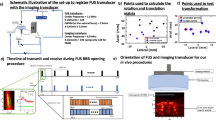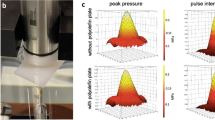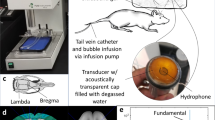Abstract
The blood–brain barrier (BBB) is the main obstacle to the effective delivery of therapeutic agents to the brain, compromising treatment efficacy for a variety of neurological disorders. Intra-arterial (IA) injection of hyperosmotic mannitol has been used to permeabilize the BBB and improve parenchymal entry of therapeutic agents following IA delivery in preclinical and clinical studies. However, the reproducibility of IA BBB manipulation is low and therapeutic outcomes are variable. We demonstrated that this variability could be highly reduced or eliminated when the procedure of osmotic BBB opening is performed under the guidance of interventional MRI. Studies have reported the utility and applicability of this technique in several species. Here we describe a protocol to open the BBB by IA injection of hyperosmotic mannitol under the guidance of MRI in mice. The procedures (from preoperative preparation to postoperative care) can be completed within ~1.5 h, and the skill level required is on par with the induction of middle cerebral artery occlusion in small animals. This MRI-guided BBB opening technique in mice can be utilized to study the biology of the BBB and improve the delivery of various therapeutic agents to the brain.
This is a preview of subscription content, access via your institution
Access options
Access Nature and 54 other Nature Portfolio journals
Get Nature+, our best-value online-access subscription
$29.99 / 30 days
cancel any time
Subscribe to this journal
Receive 12 print issues and online access
$259.00 per year
only $21.58 per issue
Buy this article
- Purchase on Springer Link
- Instant access to full article PDF
Prices may be subject to local taxes which are calculated during checkout











Similar content being viewed by others
Data availability
Source data are provided with this paper. The other data that support the findings of this study are available from the corresponding author upon reasonable request.
Code availability
The code used in this study is provided in Supplementary Data 1. We have also deposited the code and a demonstration of image processing at https://github.com/dychuchengyan/ChengyanMRI.
References
Nduom, E. K., Yang, C., Merrill, M. J., Zhuang, Z. & Lonser, R. R. Characterization of the blood–brain barrier of metastatic and primary malignant neoplasms. J. Neurosurg. 119, 427–433 (2013).
Budde, M. D., Janes, L., Gold, E., Turtzo, L. C. & Frank, J. A. The contribution of gliosis to diffusion tensor anisotropy and tractography following traumatic brain injury: validation in the rat using Fourier analysis of stained tissue sections. Brain 134, 2248–2260 (2011).
Pardridge, W. M. The blood–brain barrier: bottleneck in brain drug development. NeuroRx 2, 3–14 (2005).
Goldstein, G. W. & Betz, A. L. The blood–brain barrier. Sci. Am. 255, 74–7 (1986).
Chakraborty, S. et al. Superselective intraarterial cerebral infusion of cetuximab after osmotic blood/brain barrier disruption for recurrent malignant glioma: phase I study. J. Neurooncol. 128, 405–415 (2016).
Gonzales-Portillo, G. S. et al. Mannitol-enhanced delivery of stem cells and their growth factors across the blood–brain barrier. Cell Transplant. 23, 531–539 (2014).
Brightman, M. W., Hori, M., Rapoport, S. I., Reese, T. S. & Westergaard, E. Osmotic opening of tight junctions in cerebral endothelium. J. Comp. Neurol. 152, 317–325 (1973).
Foley, C. P. et al. Intra-arterial delivery of AAV vectors to the mouse brain after mannitol mediated blood brain barrier disruption. J. Control. Release 196, 71–78 (2014).
Burkhardt, J. K. et al. Intra-arterial delivery of bevacizumab after blood–brain barrier disruption for the treatment of recurrent glioblastoma: progression-free survival and overall survival. World Neurosurg. 77, 130–134 (2012).
Joshi, S. et al. Inconsistent blood brain barrier disruption by intraarterial mannitol in rabbits: implications for chemotherapy. J. Neurooncol. 104, 11–19 (2011).
Janowski, M., Walczak, P. & Pearl, M. S. Predicting and optimizing the territory of blood–brain barrier opening by superselective intra-arterial cerebral infusion under dynamic susceptibility contrast MRI guidance. J. Cereb. Blood Flow. Metab. 36, 569–575 (2016).
Kaya, M. et al. The effects of magnesium sulfate on blood–brain barrier disruption caused by intracarotid injection of hyperosmolar mannitol in rats. Life Sci. 76, 201–212 (2004).
Yang, W. L. et al. Evaluation of systemically administered radiolabeled epidermal growth factor as a brain tumor targeting agent. J. Neuro-Oncol. 55, 19–28 (2001).
Tajiri, N., Lee, J. Y., Acosta, S., Sanberg, P. R. & Borlongan, C. V. Breaking the blood–brain barrier with mannitol to aid stem cell therapeutics in the chronic stroke brain. Cell Transplant. 25, 1453–1460 (2016).
Seyfried, D. M. et al. Mannitol enhances delivery of marrow stromal cells to the brain after experimental intracerebral hemorrhage. Brain Res. 1224, 12–19 (2008).
Fu, H. et al. Self-complementary adeno-associated virus serotype 2 vector: global distribution and broad dispersion of AAV-mediated transgene expression in mouse brain. Mol. Ther. 8, 911–917 (2003).
Janowski, M. et al. Cell size and velocity of injection are major determinants of the safety of intracarotid stem cell transplantation. J. Cereb. Blood Flow. Metab. 33, 921–927 (2013).
Walczak, P. et al. Real-time MRI for precise and predictable intra-arterial stem cell delivery to the central nervous system. J. Cereb. Blood Flow Metab. 37, 2346–2358 (2016).
Zawadzki, M. et al. Real-time MRI guidance for intra-arterial drug delivery in a patient with a brain tumor: technical note. BMJ Case Rep. 12, e014469 (2019).
Doyle, A., McGarry, M. P., Lee, N. A. & Lee, J. J. The construction of transgenic and gene knockout/knockin mouse models of human disease. Transgenic Res. 21, 327–349 (2012).
Rivera, J., Sobey, C. G., Walduck, A. K. & Drummond, G. R. Nox isoforms in vascular pathophysiology: insights from transgenic and knockout mouse models. Redox Rep. 15, 50–63 (2010).
Bartke, A. New findings in gene knockout, mutant and transgenic mice. Exp. Gerontol. 43, 11–14 (2008).
Chu, C. et al. Real-time MRI guidance for reproducible hyperosmolar opening of the blood–brain barrier in mice. Front. Neurol. 9, 921 (2018).
Chu, C. et al. Optimization of osmotic blood–brain barrier opening to enable intravital microscopy studies on drug delivery in mouse cortex. J. Control. Release 317, 312–321 (2020).
Lesniak, W. G. et al. PET imaging of distinct brain uptake of a nanobody and similarly-sized PAMAM dendrimers after intra-arterial administration. Eur. J. Nucl. Med. Mol. Imaging 46, 1940–1951 (2019).
Lesniak, W. G. et al. A distinct advantage to intraarterial delivery of (89)Zr-bevacizumab in PET imaging of mice with and without osmotic opening of the blood–brain barrier. J. Nucl. Med. 60, 617–622 (2019).
Liu, R., Martuza, R. L. & Rabkin, S. D. Intracarotid delivery of oncolytic HSV vector G47Delta to metastatic breast cancer in the brain. Gene Ther. 12, 647–654 (2005).
Choonara, Y. E., Kumar, P., Modi, G. & Pillay, V. Improving drug delivery technology for treating neurodegenerative diseases. Expert Opin. Drug Deliv. 13, 1029–1043 (2016).
Niu, X., Chen, J. & Gao, J. Nanocarriers as a powerful vehicle to overcome blood–brain barrier in treating neurodegenerative diseases: focus on recent advances. Asian J. Pharm. Sci. 14, 480–496 (2019).
Cerri, S. et al. Intracarotid infusion of mesenchymal stem cells in an animal model of parkinson’s disease, focusing on cell distribution and neuroprotective and behavioral effects. Stem Cells Transl. Med. 4, 1073–1085 (2015).
Kijima, N. & Kanemura, Y. Mouse models of glioblastoma. in Glioblastoma (ed. De Vleeschouwer, S.) Ch. 7 (Codon Publications, 2017).
Lan, X. et al. Modeling human pediatric and adult gliomas in immunocompetent mice through costimulatory blockade. Oncoimmunology 9, 1776577 (2020).
Hall, A. M. & Roberson, E. D. Mouse models of Alzheimer’s disease. Brain Res. Bull. 88, 3–12 (2012).
Schober, A. Classic toxin-induced animal models of Parkinson’s disease: 6-OHDA and MPTP. Cell Tissue Res. 318, 215–224 (2004).
Lipsman, N. et al. Blood–brain barrier opening in Alzheimer’s disease using MR-guided focused ultrasound. Nat. Commun. 9, 2336 (2018).
Mainprize, T. et al. Blood–brain barrier opening in primary brain tumors with non-invasive MR-guided focused ultrasound: a clinical safety and feasibility study. Sci. Rep. 9, 321 (2019).
Meng, Y. et al. Safety and efficacy of focused ultrasound induced blood–brain barrier opening, an integrative review of animal and human studies. J. Control. Release 309, 25–36 (2019).
Silburt, J., Lipsman, N. & Aubert, I. Disrupting the blood–brain barrier with focused ultrasound: perspectives on inflammation and regeneration. Proc. Natl Acad. Sci. USA. 114, E6735–E6736 (2017).
Polycarpou, A. et al. Adaptation of the cerebrocortical circulation to carotid artery occlusion involves blood flow redistribution between cortical regions and is independent of eNOS. Am. J. Physiol. Heart Circ. Physiol. 311, H972–H980 (2016).
Yoshizaki, K. et al. Chronic cerebral hypoperfusion induced by right unilateral common carotid artery occlusion causes delayed white matter lesions and cognitive impairment in adult mice. Exp. Neurol. 210, 585–591 (2008).
Lacolley, P. et al. Occipital artery injections of 5-HT may directly activate the cell bodies of vagal and glossopharyngeal afferent cell bodies in the rat. Neuroscience 143, 289–308 (2006).
Gillilan, L. A. Potential collateral circulation to the human cerebral cortex. Neurology 24, 941–948 (1974).
Cuccione, E., Padovano, G., Versace, A., Ferrarese, C. & Beretta, S. Cerebral collateral circulation in experimental ischemic stroke. Exp. Transl. Stroke Med. 8, 2 (2016).
McGraw, C. P. & Howard, G. Effect of mannitol on increased intracranial pressure. Neurosurgery 13, 269–271 (1983).
Schwarz, S., Schwab, S., Bertram, M., Aschoff, A. & Hacke, W. Effects of hypertonic saline hydroxyethyl starch solution and mannitol in patients with increased intracranial pressure after stroke. Stroke 29, 1550–1555 (1998).
Cosolo, W. C., Martinello, P., Louis, W. J. & Christophidis, N. Blood–brain barrier disruption using mannitol: time course and electron microscopy studies. Am. J. Physiol. 256, R443–R447 (1989).
Fredericks, W. R. & Rapoport, S. I. Reversible osmotic opening of the blood–brain barrier in mice. Stroke 19, 266–268 (1988).
Doolittle, N. D., Muldoon, L. L., Culp, A. Y. & Neuwelt, E. A. Delivery of chemotherapeutics across the blood–brain barrier: challenges and advances. Adv. Pharmacol. 71, 203–243 (2014).
Guzman, R., Janowski, M. & Walczak, P. Intra-arterial delivery of cell therapies for stroke. Stroke 49, 1075–1082 (2018).
Golubczyk, D. et al. Endovascular model of ischemic stroke in swine guided by real-time MRI. Sci. Rep. 10, 17318 (2020).
Yang, W. et al. Enhanced survival of glioma bearing rats following boron neutron capture therapy with blood–brain barrier disruption and intracarotid injection of boronophenylalanine. J. Neurooncol. 33, 59–70 (1997).
Neuwelt, E. A. et al. Delivery of melanoma-associated immunoglobulin monoclonal antibody and Fab fragments to normal brain utilizing osmotic blood–brain barrier disruption. Cancer Res. 48, 4725–4729 (1988).
Kozler, P., Riljak, V., Jandova, K. & Pokorny, J. CT imaging and spontaneous behavior analysis after osmotic blood–brain barrier opening in Wistar rat. Physiol. Res. 63, S529–S534 (2014).
Chi, O. Z., Liu, X. & Weiss, H. R. Effects of mild hypothermia on blood–brain barrier disruption during isoflurane or pentobarbital anesthesia. Anesthesiology 95, 933–938 (2001).
Godinho, B. et al. Transvascular delivery of hydrophobically modified siRNAs: gene silencing in the rat brain upon disruption of the blood–brain barrier. Mol. Ther. 26, 2580–2591 (2018).
Martin, J. A.; Maris, A. S.; Ehtesham, M.; Singer, R. J., Rat model of blood–brain barrier disruption to allow targeted neurovascular therapeutics. J. Vis. Exp. 2012, e50019.
Bhattacharjee, A. K., Nagashima, T., Kondoh, T. & Tamaki, N. Quantification of early blood–brain barrier disruption by in situ brain perfusion technique. Brain Res. Brain Res. Protoc. 8, 126–131 (2001).
Ju, F. et al. Increased BBB permeability enhances activation of microglia and exacerbates loss of dendritic spines after transient global cerebral ischemia. Front. Cell Neurosci. 12, 236 (2018).
Acknowledgements
This work was financially supported by 2017-MSCRFF-3942, 2019-MSCRFF-5031, NIH R01NS091110, R01NS102675 and R21NS091599. We thank I.-H. Wu for preparing Fig. 1 and B. Pocta for editorial assistance.
Author information
Authors and Affiliations
Contributions
P.W., M.J., M.P., T.M., S.L. and C.C. contributed to conception and design; C.C., A.J., W.J., Y.G. and X.L. conducted the experiments; C.C., Y.G., G.L. and Y.L. analyzed and interpreted the data; C.C. drafted the manuscript, with revision from A.J., Y.G., X.L., Y.L., W.J., G.L., S.L., T.M., M.P., M.J. and P.W.
Corresponding author
Ethics declarations
Competing interests
M.P., M.J. and P.W. are founders and equity holders in Intra-ART. M.J. and P.W. are founders and equity holders in Ti-Com.
Additional information
Peer review information Nature Protocols thanks Mark S. Bolding, Laura M. Vecchio and the other, anonymous, reviewer(s) for their contribution to the peer review of this work.
Publisher’s note Springer Nature remains neutral with regard to jurisdictional claims in published maps and institutional affiliations.
Related links
Key references using this protocol
Chu, C. et al. Front. Neurol. 9, 921 (2018): https://doi.org/10.3389/fneur.2018.00921
Lesniak, W. G. et al. J. Nucl. Med. 60, 617–622 (2019): https://doi.org/10.2967/jnumed.118.218792
Janowski, M. et al. J. Cereb. Blood Flow Metab. 36, 569–575 (2016): https://doi.org/10.1177/0271678X15615875
Supplementary information
Supplementary Information
Supplementary Figs. 1–4 and Supplementary Methods.
Supplementary Data 1
Matlab code and a demonstration of image processing
Supplementary Video 1
Temporary ligation of ECA and OA cauterization
Supplementary Video 2
Temporary ligation of PPA
Supplementary Video 3
Catheter cannulation
Supplementary Video 4
Brain perfusion of a contrast agent under real-time MRI
Supplementary Video 5
Postoperative procedures
Source data
Source Data Fig. 8
Statistical source data.
Source Data Fig. 9
Statistical source data.
Source Data Fig. 10
Statistical source data.
Source Data Fig. 11
Statistical source data.
Rights and permissions
About this article
Cite this article
Chu, C., Jablonska, A., Gao, Y. et al. Hyperosmolar blood–brain barrier opening using intra-arterial injection of hyperosmotic mannitol in mice under real-time MRI guidance. Nat Protoc 17, 76–94 (2022). https://doi.org/10.1038/s41596-021-00634-x
Received:
Accepted:
Published:
Issue Date:
DOI: https://doi.org/10.1038/s41596-021-00634-x
This article is cited by
-
Blood–Brain Barrier Disruption for the Treatment of Primary Brain Tumors: Advances in the Past Half-Decade
Current Oncology Reports (2024)
-
A Perfused In Vitro Human iPSC-Derived Blood–Brain Barrier Faithfully Mimics Transferrin Receptor-Mediated Transcytosis of Therapeutic Antibodies
Cellular and Molecular Neurobiology (2023)
-
Nanomedicine approaches for medulloblastoma therapy
Journal of Pharmaceutical Investigation (2023)
Comments
By submitting a comment you agree to abide by our Terms and Community Guidelines. If you find something abusive or that does not comply with our terms or guidelines please flag it as inappropriate.



